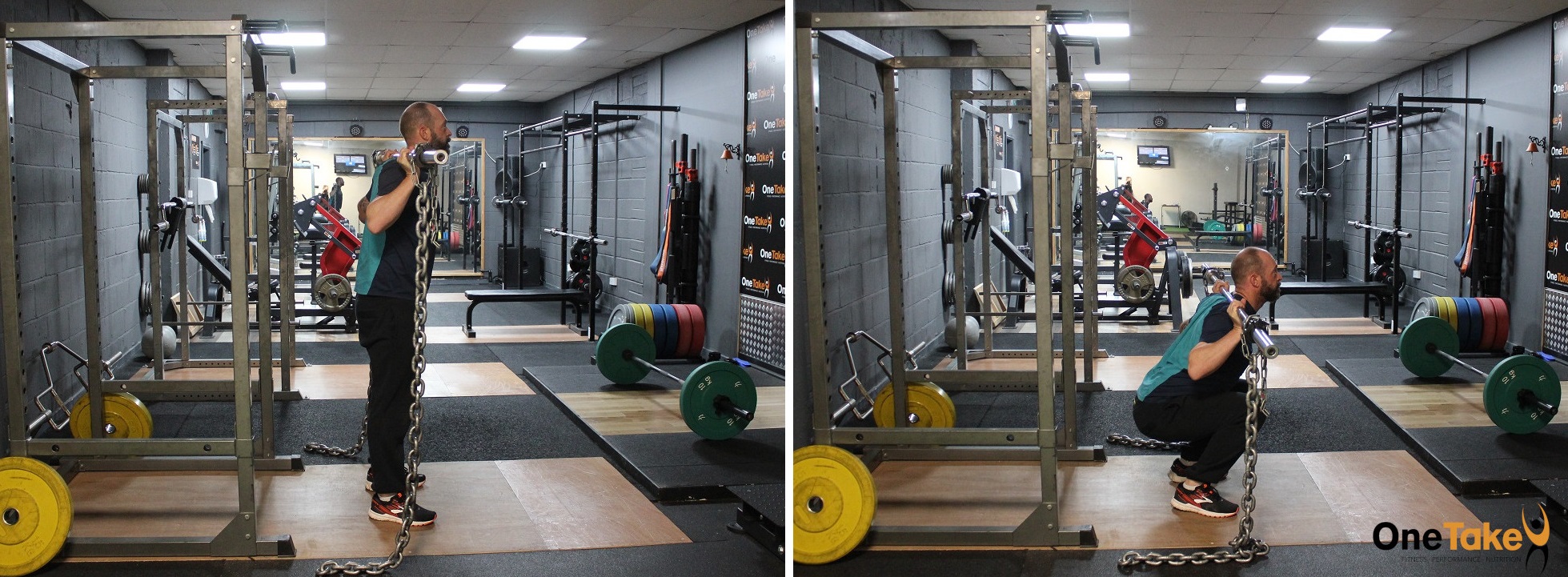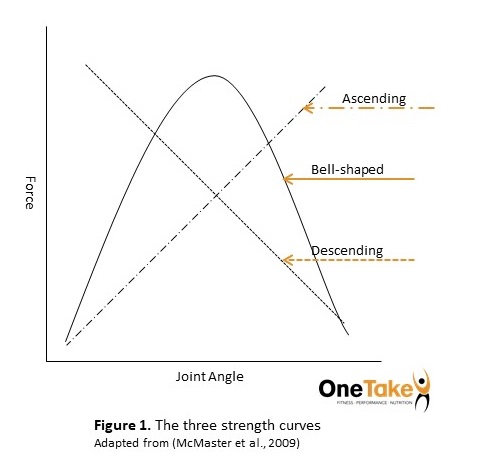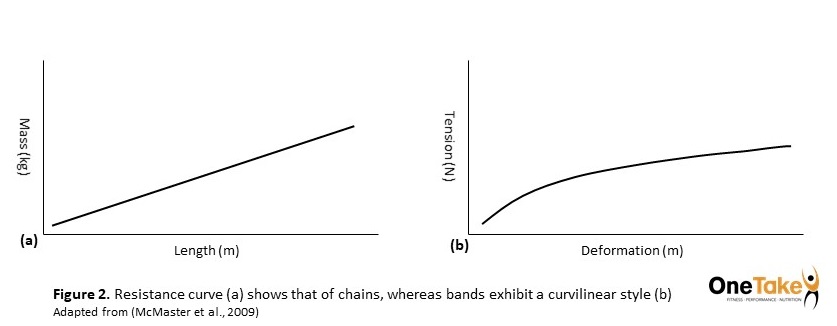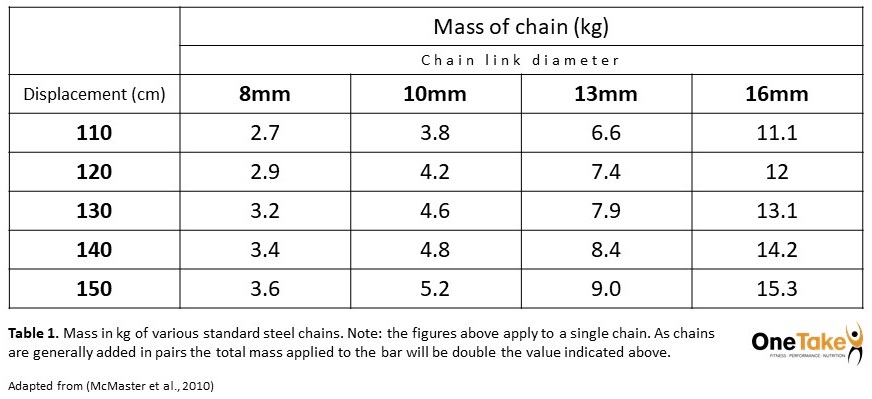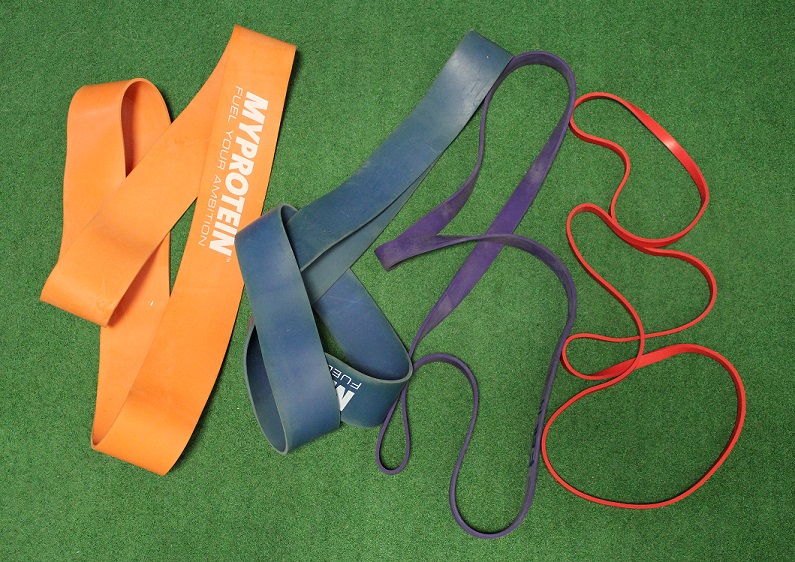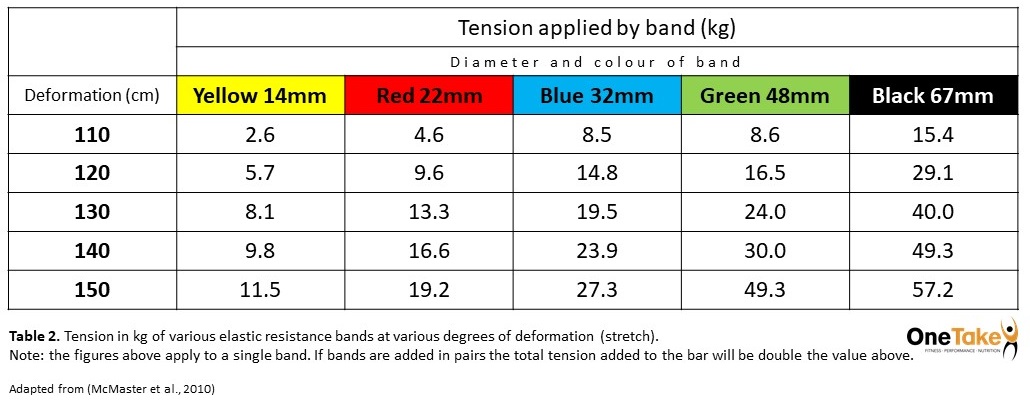Blog Post
Accomodating resistance – when should you use bands or chains?
Accommodating resistance, often termed “bands and chains” is an unconventional training methodology that is rapidly gaining popularity.
Over the last decade or so, there has been an increasing popularity for the use of unconventional objects in strength and conditioning (1) programming. Usually this is to increase sporting performance or to provide a different stimulus, but occasionally also just to add variety to an athlete’s training programme. One such unconventional method that has not only gained popularity with coaches, athletes and recreational weightlifters but has also been subject to an increase in research, is the use of accommodating resistance (AR), often termed “bands and chains”. The use of AR is certainly not a new thing, Louis Simmons owner and creator of the famous Westside Barbell has always been a big advocate of using bands and chains to provide AR (2). In fact, one of his articles in Powerlifting USA magazine from over 20 years ago is regularly cited in academic research (3). The aim of this article is to look at what exactly AR is, and how and when you should use it.
What is accommodating resistance
Traditional free-weights resistance training, such as a barbell squat, provides a constant external mass throughout the exercise. The external mass applied during a 100kg squat will always be 100kg throughout the full range of motion (ROM). Accommodating resistance on the other hand, is a method of adding ‘variable resistance’ to these movements, either through the addition of elastic bands or chains. These then either increase or decrease the load applied to the bar, depending upon its position in the exercise. Taking the squat as an example, during the concentric phase, as the trainee stands up, a greater load is applied to the bar. Conversely, during the eccentric lowering phase, the load applied is reduced (4–6). Some practitioners believe the use of AR training to be superior to traditional resistance training, due to the additional amount of work (where work=force x displacement) that is done when utilising this modality (7).
Evidence has demonstrated the use of AR to have a positive impact on strength (2,3,8,9), power (6,10,11), force production (7,10,11), rate of force development (RFD) (12), velocity (4,11) and muscle activation (6,11). Many coaches also advocate the use of AR as a method of reducing the biomechanically disadvantaged positions or “sticking points” in resistance exercises (6), demonstrating that AR does indeed have a part to play for both athletes and recreational weightlifters alike. However, before you run off and start adding chains to bars, there is a little more we need to understand, beginning with the concept of strength curves (SC).
“
Some practitioners believe the use of accomodating resistance to be superior to traditional resistance training.
“
The human strength curve describes the relationship between maximum muscle force and joint angle (torque) about a single joint. Three types of SC have been defined; ascending, descending and bell-shaped (5,13,14) (Figure 1). Ascending SCs typically feel easier as you near full extension, where the concentric portion of the exercise involves straightening your limbs. Examples of exercises that exhibit ascending SCs are squats, deadlifts and upper body pressing movements.
The descending SC on the other hand, typically feels harder where maximum strength is needed at the end of the concentric phase, as you near full joint flexion. Exercises that exhibit this are rows, face pulls and leg curls. In the bell-shaped SC, maximum strength is required around the middle of the ROM, these exercises typically feel easier at the endpoints. The best example of a bell-shaped SC is the bicep curl. It is important to understand these different SCs when prescribing AR to exercises.
Bands and chains both deliver a similar outcome, in that they administer an increase in resistance throughout the exercise ROM. The delivery mechanism, however, is somewhat different. Bands are typically polymer-based and as such the tension they apply to the exercise is dependent upon their deformation when stretched. This results in a curvilinear resistance curve (RC), chains on the other hand, produce a linear RC (Figure 2). Here the mass applied to the exercise is due to the vertical displacement of the chain (5), or, how much chain is lifted and how much remains on the ground. Ultimately, this means that AR is only beneficial to exercises that exhibit an ascending SC,
Using chains
As previously mentioned, chains exhibit a linear RC and therefore alter the kinetics of the exercise in a uniform manner throughout the ROM. Using the barbell squat as an example, when the athlete is at the base of the squat, they are in a biomechanically disadvantaged position. Joints are in a high degree of flexion and the musculoskeletal system’s ability to apply torque is reduced. With the addition of chains, at the base of the squat, the majority of the chain links are on the floor. The AR applied by the chains to the bar in this position is therefore minimal. During the concentric portion of the lift, as the athlete ascends out of the squat and moves to a biomechanically advantaged position, chain links leave the floor and progressively apply load throughout the lift. This increases the loading at the more biomechanically advantaged position, when the joints move towards full extension and the ability to apply torque is increased. Conversely, during the eccentric phase, the athlete moves from a biomechanically advantaged position, full extension, to a much-weakened position. The load applied to the bar gradually decreases as chain links gather on the floor (5,9,15). One would expect that the numerous benefits of chains would be transferable to Olympic lifting, however, this has not been shown to be the case (16).
As practitioners, it is important to understand how much additional load is applied during the lift. The structure of the chain; the density of the steel, along with link diameter and length are determinants of chain weight and must be appreciated to prescribe loading intensities. To this end, back in 2004 and again in 2010 a group of researchers developed a simple chart based upon a range of different link sizes and chain lengths (15,17). By using this chart along with an awareness of the linear RC that chains exhibit, it becomes relatively straightforward to calculate the load applied (Table 1).
Using bands
Resistance bands are commonplace within rehabilitation (18) as well as being popular with the general public and personal trainers alike, as a cheap, easily accessible home exercise modality. However, their use within strength and conditioning is gaining popularity as a method of applying AR (14). As previously mentioned, resistance bands apply tension in a curvilinear manner (Figure 2), since the deformation-tension curve of bands also relates closely to an ascending SC. This theoretically means that, as with chains, exercises possessing this type of SC are ideal candidates when applying AR. Traditional free-weights’ exercises and AR using chains rely on the effects of gravity to apply force. Bands on the other hand, have the ability to apply resistance in multiple planes (5). This is a distinct advantage over chains providing more versatility to the coach. Researchers have also shown that the curvilinear nature of their RC is particularly beneficial in the development of force and acceleration (5,19), making them an ideal candidate for athletes in power-based sports.
“
The ability to apply resistance in different planes, gives bands a distinct advantage over chains.
“
Figure 3. Assorted resistance bands
Calculation of the additional load or tension applied by bands is more complex than that of chains and relies on Hooke’s law. Here the tension (T) provided by the band can be calculated by the equation T=kd where k is equal to the stiffness constant of the band and d is the deformation, or length the band is stretched (5). Resistance bands designed for strength and conditioning are typically manufactured in varying colour coded widths (Figure 3) with the wider bands exhibiting greater stiffness and therefore higher tension. However, asking an equipment supplier what the stiffness constant of the band is, will probably result in a blank look. The good news is that many manufacturers stamp bands with the typical range of tension that they exert. One group of researchers went even further and produced a representation of how much tension is applied when bands are stretched to various lengths (Table 2) (17).
Although this removes much of the guesswork for the coach, it is important to remember this is only a guide, and not only will band sizes and stiffnesses vary between manufacturers, but the age of the band will affect the results too.
My thoughts
The use of AR provides coaches with additional tools to enhance traditional resistance training and improve different performance indicators. Although chains have been shown not to benefit Olympic lifting, practically, their linear RC makes prediction of load simpler. However, despite the complexity of calculating load applied, bands appear to be more versatile and certainly more portable as well as more beneficial to power athletes. Regardless of the option selected, they should only be used for exercises that exhibit an ascending SC. Researchers also appear to agree that optimal loading should be 20-50% of the trainee’s 1 repetition-maximum (4,7,9), with noticeable performance improvements occurring in around 7 weeks (8,9,19).
“
Bands or chains should only be used with exercises that exhibit an ascending strength curve.
“
Summary
- Only use AR with exercises that exhibit an ascending SC
- Bands are more versatile and portable, but load calculation is more complex
- Bands are more beneficial to power athletes than chains
- Loading should be in the region of 20-50% 1-RM
- Noticeable results are evident after around 7 weeks of use
Rererences (click to expand)
- Zemke B, Wright G. The use of strongman type implements and training to increase sport performance in collegiate athletes. Strength Cond J. 2011 Aug;33(4):1–7.
- Simmons L. The Westside Barbell book of methods. USA: Westside Barbell; 2007.
- Simmons L. Bands and chains. Powerlifting USA. 1999;22(6):26–7.
- Baker DG, Newton RU. Effect of kinetically altering a repetition via the use of chain resistance on velocity during the bench press: J Strength Cond Res. 2009 Oct;23(7):1941–6.
- McMaster DT, Cronin J, McGuigan M. Forms of Variable Resistance Training. Strength Cond J. 2009 Feb;31(1):50–64.
- Scott DJ, Ditroilo M, Marshall P. Effect of accommodating resistance on the postactivation potentiation response in Rugby League players. J Strength Cond Res. 2018 Sep;32(9):2510–20.
- Nijem RM, Coburn JW, Brown LE, Lynn SK, Ciccone AB. Electromyographic and force plate analysis of the deadlift performed with and without chains. J Strength Cond Res. 2016 May;30(5):1177–82.
- Federici A, Zumbo F, Raiola G. Use of chains as a means of intensifying the load in resistance training. J Phys Educ Sport. 2019;19(2):466–72.
- Ghigiarelli JJ, Nagle EF, Gross FL, Robertson RJ, Irrgang JJ, Myslinski T. The effects of a 7-week heavy elastic band and weight chain program on upper-body strength and upper-body power in a sample of division 1-AA football players: J Strength Cond Res. 2009 May;23(3):756–64.
- Aboodarda SJ, Yusof A, Osman NAA, Thompson MW, Mokhtar AH. Enhanced performance with elastic resistance during the eccentric phase of a countermovement jump. Int J Sports Physiol Perform. 2013 Mar;8(2):181–7.
- Israetel MA, McBride JM, Nuzzo JL, Skinner JW, Dayne AM. Kinetic and kinematic differences between squats performed with and without elastic bands: J Strength Cond Res. 2010 Jan;24(1):190–4.
- Stevenson MW, Warpeha JM, Dietz CC, Giveans RM, Erdman AG. Acute effects of elastic bands during the free-weight barbell back squat exercise on velocity, power, and force production: J Strength Cond Res. 2010 Nov;24(11):2944–54.
- Kulig K, Andrews JG, Hay JG. Human strength curves. Exerc Sport Sci Rev. 1984 Jan;12(1):417–66.
- Wilson J, Kritz M. Practical guidelines and considerations for the use of elastic bands in strength and conditioning: Strength Cond J. 2014 Oct;36(5):1–9.
- Berning JM, Coker CA, Adams KJ. Using chains for strength and conditioning. Strength Cond J. 2004 Oct;26(5):80–4.
- Berning JM, Coker CA, Briggs D. The biomechanical and perceptual influence of chain resistance on the performance of the Olympic clean. J Strength Cond Res. 2008 Mar;22(2):390–5.
- McMaster DT, Cronin J, McGuigan MR. Quantification of rubber and chain-based resistance modes. J Strength Cond Res. 2010 Aug;24(8):2056–64.
- Andersen LL, Andersen CH, Mortensen OS, Poulsen OM, Bjørnlund IBT, Zebis MK. Muscle activation and perceived loading during rehabilitation exercises: comparison of dumbbells and elastic resistance. Phys Ther. 2010 Apr 1;90(4):538–49.
- Wallace BJ, Winchester JB, McGuigan MR. Effects of elastic bands on force and power characteristics during the back squat exercise. J Strength Cond Res. 2006 May;20(2):268–72.
Connect
While you’re here, why not connect with us on our social media channels.

